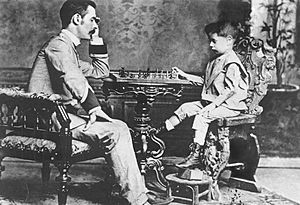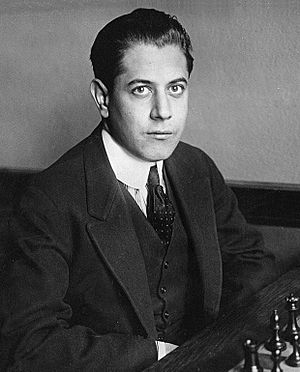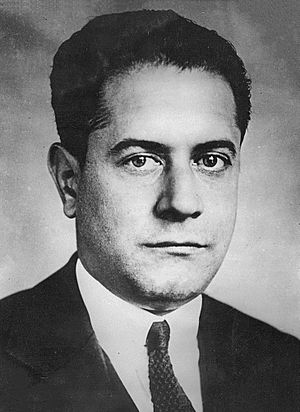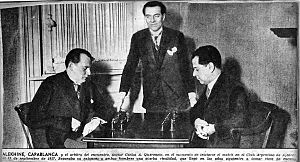José Raúl Capablanca facts for kids
Quick facts for kids José Raúl Capablanca |
|
|---|---|
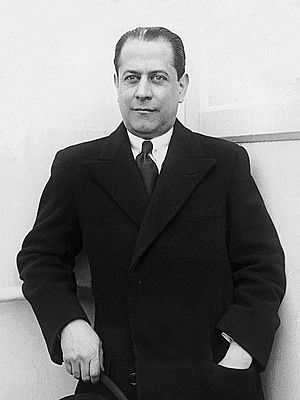
Capablanca in 1931
|
|
| Full name | José Raúl Capablanca y Graupera |
| Country | Cuba |
| Born | 19 November 1888 Havana, Cuba |
| Died | 8 March 1942 (aged 53) New York, New York, U.S. |
| World Champion | 1921–1927 |
José Raúl Capablanca y Graupera (born November 19, 1888 – died March 8, 1942) was a famous chess player from Cuba. He was the world chess champion from 1921 to 1927.
Capablanca was a chess prodigy, meaning he was incredibly talented at a young age. People remember him for his amazing skill in the endgame (the final part of a chess game) and how fast he played. He was undefeated for a long time, from 1916 to 1924.
He won the world title from Emanuel Lasker in 1921. Later, he lost his title to Alexander Alekhine in 1927. Capablanca kept playing well in tournaments but stopped playing serious chess in 1931. He returned in 1934 but had health problems. He died in 1942 from a brain hemorrhage.
Capablanca was great at simple chess positions and endgames. Many chess experts, like Bobby Fischer, praised his playing style. He also wrote several chess books. His book Chess Fundamentals is considered one of the best chess books ever. His calm and clear style of play influenced future world champions like Bobby Fischer and Anatoly Karpov.
Contents
Who was José Raúl Capablanca?
His early life and learning chess
José Raúl Capablanca was born in Havana, Cuba, on November 19, 1888. His father was a Spanish army officer. Capablanca said he learned chess at age four by watching his father play. He even spotted an illegal move his father made! Then, he beat his father in a game.
When he was eight, he visited the Havana Chess Club. Doctors advised him not to play too often. In 1901, just before his 13th birthday, he narrowly beat the Cuban Chess Champion, Juan Corzo.
In 1905, Capablanca went to Columbia College (New York). He wanted to play for their strong baseball team. He also joined the Manhattan Chess Club and quickly became their best player. He was especially good at rapid chess. In 1906, he won a rapid chess tournament, even beating the World Champion, Emanuel Lasker. He left university in 1908 to focus on chess.
Becoming a chess star
Capablanca's speed in chess made him great at simultaneous exhibitions. In these events, one player plays many opponents at once. In 1909, he toured the U.S., playing 602 games in 27 cities. He won an amazing 96.4% of his games!
This success led to a match against Frank Marshall, the U.S. champion. Capablanca won the match easily, 15–8. After this win, Capablanca said he had never read a book on chess openings.
In 1911, Capablanca played in the San Sebastian chess tournament in Spain. This was a very strong tournament with many top players. Some players objected to Capablanca joining because he was so young. But Capablanca won the tournament, surprising the chess world. He beat famous players like Akiba Rubinstein and Aron Nimzowitsch. This win made him a serious contender for the world championship.
Aiming for the world title
In 1911, Capablanca challenged Emanuel Lasker for the World Chess Championship. Lasker agreed but set 17 conditions for the match. Capablanca disagreed with some of these rules, so the match did not happen.
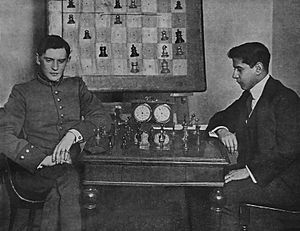
In 1913, Capablanca won a tournament in New York. He then came second in Havana, losing one game to Marshall. Later that year, he won all 13 games in another New York tournament.
In September 1913, Capablanca got a job with the Cuban Foreign Office. This job gave him financial security. He was expected to travel and represent Cuba. His first trip was to Saint Petersburg for a major tournament. On his way, he played exhibition games in London, Paris, and Berlin, winning all of them.
The St. Petersburg 1914 chess tournament was the first time Capablanca played against Emanuel Lasker in a tournament. Capablanca led in the first part of the tournament. But Lasker played very well in the final rounds and won the tournament by half a point.
After this, Capablanca helped create new rules for future World Championship matches. These rules said the champion should defend their title every year. They also set a minimum prize money.
Chess during World War I
World War I stopped most international chess for over four years. Capablanca continued to win tournaments in New York in 1914, 1915, 1916, and 1918. He lost only one game during this time.
In the 1918 tournament, Marshall used a new, complex opening against Capablanca. This opening is now known as the Marshall Attack. Marshall had kept this secret for years. Even though it was very complicated, Capablanca found a way to win the game.
In 1919, Capablanca played a match against Borislav Kostić. Kostić had been undefeated in the 1918 tournament. The match was supposed to go to the first player to win eight games. But Kostić gave up after losing the first five games. Capablanca felt he was at his strongest during this period.
Becoming World Champion
In 1919, Capablanca won the Hastings tournament. He scored 10½ points out of 11, showing his dominance.
In 1920, Emanuel Lasker and Capablanca agreed to play a World Championship match in 1921. Lasker then resigned his title to Capablanca in June 1920. He said Capablanca had earned the title through his "brilliant mastery." However, most people and chess historians believe Capablanca officially became World Champion by beating Lasker in their 1921 match.
The match took place in March–April 1921 in Havana. Lasker gave up after 14 games, having lost four games and won none. Some thought Lasker was not in good form or was affected by the climate. Others said Capablanca was younger and a bit stronger.
As World Champion, Capablanca won the London tournament of 1922. He scored 13 points out of 15 and had no losses. During this event, Capablanca suggested new "London Rules" for future World Championship matches. These rules aimed to make challenges fairer and easier to arrange. Many top players signed them.
In 1922, Capablanca also gave a huge simultaneous exhibition in Cleveland. He played against 103 opponents, winning 102 games and drawing one. This set a record for the best winning percentage in a large exhibition.
In 1924, Capablanca played in the New York 1924 chess tournament. He came second, behind Lasker. His loss to Richard Réti in this tournament was his first in serious competition in eight years. He also came third in the Moscow 1925 chess tournament.
In 1927, a group of Argentinian businessmen helped arrange a World Championship match between Capablanca and Alexander Alekhine. Capablanca had a great success at the New York 1927 chess tournament before the match. He finished undefeated, 2½ points ahead of Alekhine.
Capablanca married Gloria Simoni Betancourt in 1921. They had two children. Later, he met Olga Chagodaef, a Russian princess, and they married in 1938.
Losing the world title
Most experts thought Capablanca would win the World Chess Championship 1927 match against Alekhine. Capablanca had never lost a game to Alekhine before. But Alekhine won the match, played in Buenos Aires, by 6 wins, 3 losses, and 25 draws. This was a big surprise to the chess world.
After Capablanca's death, Alekhine said he was surprised by his own victory. He thought Capablanca might have been too confident. Capablanca did not prepare much for the match. Alekhine, however, prepared very well and studied Capablanca's games closely. Some say Capablanca was not used to losing and became upset during the match.
After winning, Alekhine said he would give Capablanca a rematch. But he demanded the same tough conditions Capablanca had set as champion. The challenger had to provide a large amount of money. Negotiations for a rematch went on for years but never worked out. Their relationship became difficult.
Later chess career and health issues
After losing his title in 1927, Capablanca played more tournaments. He hoped to earn a rematch. From 1928 to 1931, he won many first prizes. He played against new stars like Max Euwe. However, Capablanca and Alekhine did not play in the same tournament during this time.
Even though he had great results, Capablanca's play started to slow down. He sometimes ran out of time in games. He still played many brilliant games but also made some mistakes.
In 1931, after winning a tournament in New York, Capablanca stopped playing serious chess. He might have been discouraged by not getting a rematch with Alekhine. He mostly played casual games and simultaneous exhibitions.
In 1934, Capablanca decided to return to competitive chess. He played in the Hastings tournament of 1934–35. He also played in Moscow in 1935 and 1936. In 1936, he won a strong tournament in Moscow and shared first place in Nottingham. These were the last tournaments where he played against Lasker. During these successes, Capablanca started to show signs of high blood pressure.
His high blood pressure was not properly treated for some time. It caused him to lose focus during games. In 1938, he only finished seventh in the AVRO 1938 chess tournament, which was meant to find a challenger for Alekhine.
In 1939, Capablanca played for Cuba in the 8th Chess Olympiad in Buenos Aires. He won a gold medal for his excellent performance on the top board. During this event, Capablanca tried one last time to arrange a World Championship match with Alekhine. But Alekhine refused, saying World War II had just started.
His passing

Capablanca's high blood pressure became very dangerous. On March 7, 1942, he was watching a casual chess game at the Manhattan Chess Club in New York City. He suddenly collapsed. He was taken to Mount Sinai Hospital, where he died the next day. The cause of death was a brain hemorrhage caused by his high blood pressure.
His funeral was held in Havana's Colón Cemetery on March 15, 1942.
Tributes to a legend
Alexander Alekhine wrote a tribute to Capablanca, saying, "Capablanca was snatched from the chess world much too soon. With his death, we have lost a very great chess genius whose like we shall never see again." Emanuel Lasker once said, "I have known many chess players, but only one chess genius: Capablanca."
An annual Capablanca Memorial chess tournament has been held in Cuba since 1962 to honor him.
How good was Capablanca?
His playing style and strengths
As an adult, Capablanca lost very few serious games, only 34 in total. He was undefeated for eight years, from 1916 to 1924. During this time, he played 63 games, winning 40 and drawing 23. Only a few top players, like Marshall, Lasker, and Alekhine, managed to beat him more than once.
Chess ranking systems place Capablanca among the greatest players ever. Some studies have even found that Capablanca was one of the most accurate World Champions when compared to computer analysis.
Many chess champions admired Capablanca. Boris Spassky thought he was the best player of all time. Bobby Fischer loved Capablanca's "light touch" and his ability to find the right move very quickly.
Capablanca was excellent at simple positions and endgames. His understanding of how to place pieces (positional judgment) was outstanding. Opponents often struggled to attack him. But he could also play tactical chess when needed, especially when it helped him win. A famous example is his game against Rudolf Spielmann in 1927, where he won with brilliant tactical play.
His impact on chess
Capablanca didn't create a specific "school" of chess. But his calm and clear style influenced future world champions like Fischer, Karpov, and Botvinnik. Even Alekhine learned a lot about positional play from Capablanca before they became rivals.
As a chess writer, Capablanca focused on the most important moments in a game. He didn't include too many detailed analyses. His writing was clear and easy to understand. Many consider his book Chess Fundamentals to be one of the best chess books ever.
Capablanca also pointed out that while a bishop is usually stronger than a knight, a queen and knight together are often better than a queen and bishop, especially in endgames.
What was he like?
Early in his career, some people criticized Capablanca for sounding too proud in his first book, My Chess Career. But he later included almost all his losses in his book Chess Fundamentals to show he was willing to learn. He believed in being honest about his achievements.
Despite his chess success, Capablanca seemed more interested in baseball. He once said chess was "not a difficult game to learn and it is an enjoyable game to play." His second wife, Olga, felt he wished he could have studied music or medicine instead of chess.
Capablanca chess: a new game?
In 1925, Capablanca worried that chess might become too easy for top players to draw games. He thought that in about 50 years, chess knowledge might make the game less exciting.
So, he suggested a new chess game called Capablanca chess. It would be played on a bigger 10x8 board with two extra pieces for each side:
- A chancellor: This piece moves like a rook and a knight combined.
- An archbishop: This piece moves like a bishop and a knight combined.
He believed this would make the game more complex and prevent it from becoming boring for centuries. Capablanca suggested this idea while he was still World Champion.
Capablanca's books
Capablanca wrote several books about chess:
- Havana 1913 (1913)
- My Chess Career (1920)
- Chess Fundamentals (1921)
- The World's Championship Chess Match Played at Havana Between Jose Raul Capablanca and Dr. Emanuel Lasker (1921)
- A Primer of Chess (1935)
- Last Lectures (1966)
Tournament achievements
Capablanca had many great results in chess tournaments. Here are some of his top finishes:
| Date | Location | Place | Score | Notes | |
|---|---|---|---|---|---|
| 1910 | 1st | 6½/7 | +6−0=1 | He won the New York State Championship. | |
| 1911 | 2nd | 9½/12 | +8−1=3 | Marshall finished first. | |
| 1st | 9½/14 | +6−1=7 | He won this very strong tournament, surprising many. | ||
| 1913 | 1st | 11/13 | +10−1=2 | He finished ahead of Marshall. | |
| 2nd | 10/14 | +8−2=4 | Marshall won this tournament. | ||
| 1st | 13/13 | +13−0=0 | He won all his games in this tournament. | ||
| 1914 | 2nd | 13/18 | +10−2=6 | He finished behind Emanuel Lasker in a tough tournament. | |
| 1915 | 1st | 13/14 | +12−0=2 | He won ahead of Marshall. | |
| 1916 | 1st | 14/17 | +12−1=4 | He won this tournament with only one loss. | |
| 1918 | 1st | 10½/12 | +9−0=3 | He won ahead of Boris Kostić. | |
| 1919 | 1st | 10½/11 | +10−0=1 | He won this international competition. | |
| 1922 | 1st | 13/15 | +11−0=4 | He won without any losses. | |
| 1924 | 2nd | 14½/20 | +10−1=9 | He finished behind Lasker. | |
| 1925 | 3rd | 13½/20 | +9−2=9 | He came third in this strong tournament. | |
| 1926 | 1st | 6/8 | +4−0=4 | He won this tournament. | |
| 1927 | 1st | 14/20 | +8−0=12 | He won this tournament undefeated, ahead of Alekhine. | |
| 1928 | 2nd | 7/11 | +4−1=6 | He finished behind Bogoljubow. | |
| 1st | 7/9 | +5−0=4 | He won this tournament. | ||
| 1st | 8½/12 | +5−0=7 | He won this tournament. | ||
| 1929 | 1st | 5½/7 | +4−0=3 | He won this tournament. | |
| 2nd= | 14½/21 | +10−2=9 | He tied for second place. | ||
| 1st | 10½/13 | +8−0=5 | He won this tournament. | ||
| 1st | 13½/14 | +13−0=1 | He won this tournament with almost a perfect score. | ||
| 1929–30 | 1st | 6½/9 | +4-0=5 | He won this tournament. | |
| 1930–31 | 2nd | 6½/9 | +5−1=3 | He finished behind Euwe. | |
| 1931 | 1st | 10/11 | +9−0=2 | He won this tournament. | |
| 1934–35 | 4th | 5½/9 | +4−2=3 | He came fourth in his comeback tournament. | |
| 1935 | 4th | 12/19 | +7−2=10 | He came fourth in Moscow. | |
| 2nd | 7/9 | +6−1=2 | He finished second. | ||
| 1936 | 2nd | 7/9 | +5−0=4 | He finished second. | |
| 1st | 13/18 | +8−0=10 | He won this strong tournament in Moscow. | ||
| 1st= | 10/14 | +7−1=6 | He tied for first place with Botvinnik. | ||
| 1937 | 3rd= | 7½/14 | +2−1=11 | He tied for third place. | |
| 1938 | 1st= | 8/10 | +6−0=4 | He tied for first place. | |
| 7th | 6/14 | +2-4=8 | He came seventh in this elite tournament. | ||
| 1939 | 2nd= | 6½/9 | +4−0=5 | He tied for second place. | |
At the 1939 Chess Olympiad in Buenos Aires, Capablanca won the gold medal for the best performance on the top board for his country.
Match results
Here are Capablanca's results in important chess matches:
| Date | Opponent | Result | Location | Score | Notes | |
|---|---|---|---|---|---|---|
| 1901 | Juan Corzo | Won | Havana | 7–6 | +4−3=6 | He beat the Cuban champion. |
| 1909 | Frank James Marshall | Won | New York | 15–8 | +8−1=14 | |
| 1913 | Richard Teichmann | Won | Berlin | 2–0 | +2−0=0 | |
| 1913 | Jacques Mieses | Won | Berlin | 2–0 | +2−0=0 | |
| 1913 | Eugene Znosko-Borovsky | Drawn | St. Petersburg | 1–1 | +1−1=0 | |
| 1913 | Alexander Alekhine | Won | St. Petersburg | 2–0 | +2−0=0 | |
| 1913 | Fedor Duz-Khotimirsky | Won | St. Petersburg | 2–0 | +2−0=0 | |
| 1919 | Boris Kostić | Won | Havana | 5–0 | +5−0=0 | Kostić resigned after five games. |
| 1921 | Emanuel Lasker | Won | Havana | 9–5 | +4−0=10 | He won the World Chess Championship. |
| 1927 | Alexander Alekhine | Lost | Buenos Aires | 15½–18½ | +3−6=25 | He lost the World Chess Championship. |
| 1931 | Max Euwe | Won | Netherlands | 6–4 | +2−0=8 | Euwe later became World Champion. |
Famous games
Here are some of Capablanca's most notable chess games:
- Capablanca vs. L Molina, Buenos Aires 1911, Queen's Gambit Declined: Modern. Knight Defense (D52), 1–0 This game shows a tactical sacrifice.
- Jose Raul Capablanca vs Frank James Marshall, ch Manhattan CC, New York 1918, Spanish Game: Marshall Attack. Original Marshall Attack (C89), 1–0 This is one of Capablanca's most famous games. He defended against a very aggressive attack.
- Emanuel Lasker vs Jose Raul Capablanca, Lasker–Capablanca World Championship Match, Havana 1921. Queen's Gambit Declined: Orthodox Defense. Rubinstein Variation (D61), 0–1 A key game from his World Championship match.
- Jose Raul Capablanca vs Savielly Tartakower, New York 1924, Dutch Defense, Horwitz Variation: General (A80), 1–0 This game ends with a highly praised endgame.
- Jose Raul Capablanca vs Rudolf Spielmann, New York 1927, Queen's Gambit Declined: Barmen Variation (D37), 1–0 A tactical game that won a special prize for its brilliance.
- Ilia Abramovich Kan vs Jose Raul Capablanca, Moscow 1936, Vienna Game: Anderssen Defense (C25), 0–1 This game features one of Capablanca's most famous endgames.
Images for kids
-
First Match game between Alekhine and Capablanca on 14 December 1913 in an exhibition in St. Petersburg
-
Capablanca's grave at Colón Cemetery
See also
 In Spanish: José Raúl Capablanca para niños
In Spanish: José Raúl Capablanca para niños


